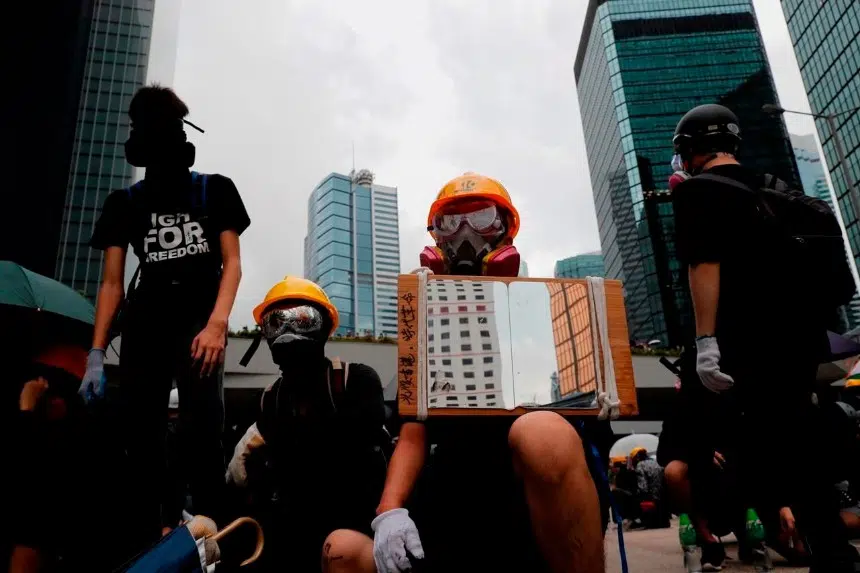HONG KONG – Protesters in Hong Kong threw gasoline bombs at government headquarters and set fires in the street on Saturday, while police fired tear gas and blue-colored water from truck-mounted cannons in the 13th consecutive weekend of anti-government and anti-police demonstrations.
The protesters provoked and obstructed the police repeatedly but generally retreated once riot officers moved in, avoiding the direct clashes that characterized earlier protests. It may have been a calculated strategy to avoid arrest, as police have been detaining more people when they move in to break up groups occupying streets.
Hong Kong, a city of 7.4 million people, has been riven by protests for nearly three months. A now-shelved extradition bill brought to the fore simmering concerns about what many in Hong Kong see as an erosion of the rights and freedoms that the semiautonomous Chinese territory is supposed to have under a “one country, two systems” framework.
Police denied permission for a march to mark the fifth anniversary of an Aug. 31, 2014, decision by China against fully democratic elections in Hong Kong, but protesters took to the streets anyway, as they have all summer.
The mostly young, black-shirted protesters took over roads and major intersections in shopping districts as they rallied and marched with no obvious destination in mind.
Authorities closed streets and a subway stop near the Chinese government office and parked water cannon trucks and erected additional barriers nearby, fearing protesters might target the building. The office would have been the endpoint of the march that police did not allow.
Instead, a group of hard-line protesters decided to take on police guarding government headquarters from behind large barriers that ring the building, keeping demonstrators at bay.
While others marched back and forth elsewhere, a large crowd wearing helmets and gas masks gathered outside. They pointed laser beams at the officers’ heads and threw objects over the barriers and at them. Police responded with tear gas, and protesters threw gasoline bombs into the compound.
Then came the blue water. A water cannon truck fired regular water, then returned with repeated bursts of colored water, staining protesters and nearby journalists and leaving blue puddles in the street.
The standoff continued for some time, but protesters started moving back as word spread that police were headed in their direction. A few front-line protesters hurled gasoline bombs at the officers in formation, but there were no major clashes as police cleared the area.
Protesters regrouped and blocked a major commercial street by piling up barricades and setting a large fire. Smoke billowed into the air as hundreds of protesters waited on the other side of the makeshift barrier, many pointing laser beams that streaked the night sky above them.
Firefighters made their way into the congested area on foot to put out the fire. Police in riot gear removed the barricades and moved in quickly. They could be seen detaining a few protesters, but by then, most had already left.
As police advanced east down Hennessey Road, protesters made another stand in the Causeway Bay shopping district. They threw gasoline bombs at police, who fired tear gas and water cannons.
Protesters built another fire, a smaller one, in front of Sogo department store. Police waited behind their riot shields while firefighters put out the smouldering fire with extinguishers. When police moved in, the protesters had again retreated.
Other groups crossed Hong Kong’s harbour to the Tsim Sha Tsui district, where police said they set fires and threw gasoline bombs on Nathan Road.
Democratic Party lawmaker Lam Cheuk-ting said Hong Kong citizens would keep fighting for their rights and freedoms despite the arrests of several prominent activists and lawmakers in the past two days, including activist Joshua Wong.
Protesters are demanding the full withdrawal of the extradition bill – which would have allowed Hong Kong residents to be sent to mainland China to stand trial – as well as democratic elections and an investigation into alleged police brutality in past battles with hard-line demonstrators.
“I do believe the government deliberately arrested several leaders of the democratic camp to try to threaten Hong Kong people not to come out to fight against the evil law,” Lam said at what was advertised as a Christian march earlier Saturday.
About 1,000 people marched to a Methodist church and police headquarters. They alternated between singing hymns and chanting slogans of the pro-democracy movement. An online flyer for the demonstration called it a “prayer for sinners” and featured images of a Christian cross and embattled Hong Kong leader Carrie Lam, who had proposed the extradition bill.
The Civil Human Rights Front, the organizer of pro-democracy marches that have drawn upward of a million people this summer, cancelled its march after failing to win police approval. Police said that while previous marches have started peacefully, they have increasingly degenerated into violence in the end.
The standing committee of China’s legislature ruled on Aug. 31, 2014, that Hong Kong residents could elect their leader directly, but that the candidates would have to be approved by a nominating committee.
The decision failed to satisfy democracy advocates in Hong Kong and led to the 79-day long Occupy Central protests that fall, in which demonstrators camped out on major streets in the financial district and other parts of the city.
The participants in the religious march Saturday were peaceful and mostly older than the younger protesters who have led this summer’s movement and, in some cases, blocked streets and battled police with bricks, sticks and gasoline bombs
Religious meetings do not require police approval, though authorities said late Friday that organizers of a procession with more than 30 people must notify police.
Associated Press videojournalists Raf Wober, Alice Fung and Johnson Lai contributed to this report.
Ken Moritsugu, The Associated Press







